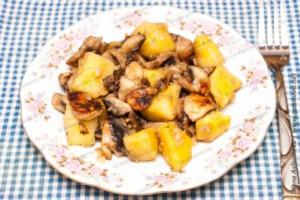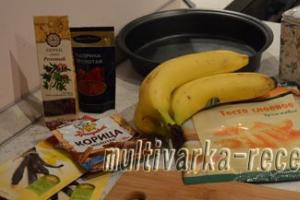Plants. There are so many of them on Earth! They surround us everywhere: both on land and in sea depths. Thanks to plants we breathe, because under the influence sun rays green spaces convert carbon dioxide into oxygen. Botanists in the process of studying various types revealed many interesting facts about plants.
The most unusual facts from the life of plants
1. Grows on planet Earth unusual plant- ceratonia. Surprisingly, it always produces seeds whose weight is exactly equal to 0.2 g. In ancient times, ceratonia seeds were used by jewelers as miniature weights, and now this measure is called a carat.
2. Rainbow eucalyptus trees with multi-colored bright bark grow on the island of Mindanao. The fact is that the bark from these trees comes off in the form of many narrow strips, and in place of the old bark a new one is formed. Initially, it is bright green in color, and as it grows and ages it turns blue, purple and even pink-orange.
3. The African savannas are home to the thickest, longest-lived trees. These are the famous baobabs. With a relatively small height of 18-25 m, the circumference of their trunk can be more than 10 m. And there are also record holders with a trunk circumference of 50 m. Their life expectancy ranges from a thousand to more than five thousand years.

4. The most ancient plant on the ground - seaweed.
5. The fastest growing tree in nature is bamboo from South and East Asia. It stretches 75-90 cm per day.
6. Interesting facts about the life of animals and plants: there are more than 10 thousand on the planet poisonous plants. For example, the Indians treated arrowheads with curare poison and went hunting for wild animals. And the natives in Africa, in order to kill a large animal on the spot, used poison from the seeds of strophanthus.

7. There are harmless-looking plants that are actually carnivorous. They are able to “eat” insects and some arthropods. These plants secrete digestive juice, with which they dissolve their prey, thereby obtaining nutrients. Such predators include: sarracenia, nepenthes, genlisea, darlingtonia, butterwort, sundew, Venus flytrap and many others.
8. In the Amazon River you can find an unusual plant of the water lily family - Victoria. Its leaves reach three meters in diameter. On their surface they can support a weight of up to 30 kg.

10. There are many long-livers among coniferous plants. And the oldest tree on the planet is pine, which is 4.5 thousand years old. It grows in the USA.
11. Scientists know interesting data about gymnosperms, of which there are more than 800 species on earth. Often trees related to gymnosperms reach gigantic sizes. Thus, a sequoia, with its average height of about 100 m, can reach 18-20 m in diameter and weigh about 1000 tons.

12. Yew - unique tree. It has several tops. When one of the tops reaches a certain size, it dies off, and the other top continues to grow.

14. There are more than 250 thousand species of angiosperms (flowering) plants on earth. They grow from the snowy Arctic to tropical forests. Angiosperms can be found not only in our usual places (garden, park), but also in water (water lilies), sandy deserts and steppes (saxaul, camel thorn).
Among the flowering plants, orchids stand out. The world's smallest orchid has flowers only 2 mm in diameter. The world's largest orchid is the tiger orchid. Its inflorescences can reach a length of up to 3 m. And there is also a type of orchid that we eat. This is vanilla bean.

15. Spore-bearing plants are also of interest. The most large group This type of plant is ferns. There are more than 300 genera and 10 thousand species. Fern plants appeared more than 350 million years ago. They grow everywhere: in the forest, on trunks and branches large trees, in a swamp, in rock crevices, in rivers and lakes, along roadsides and even on the walls of city houses.
In New Zealand, a black tree fern grows, which reaches 20 m in height and has a girth of about 50 cm. And Japanese scientists have found that the fern removes radiation from the body.

16. Second most popular spore plants are mosses, one of the most ancient plants. It is believed that mosses appeared on earth after algae and were the first plants to reach land.
17. Cultivated plants are of great value to humans, because we use their fruits for food. There are also some fascinating data about cultivated plants. For example, in ancient times it was believed that orange helps cure the plague. For this reason, juicy fruits had a sky-high price and were available only to the nobility. And the familiar strawberry is the only berry whose seeds are located on the outside and not on the inside.

18. Cultivated plants include cereals, and sometimes they are used not only for food. For example, in ancient China rice was used as a lie detector. The accused had to take a mouthful of rice and then spit it out. If the cereal remained dry, i.e. If the defendant's mouth was dry, he was found guilty.
19. Don’t forget about indoor plants. Plants and flowers in the home not only decorate the area and create coziness, but can also influence the mood and health of those who grow them. For example, aloe has medicinal properties, and Crassula, or in other words “ Money Tree", attracts positive energy into the house and attracts financial well-being.

20. Chlorophytum is good for children, as it will remove all harmful impurities from the air of the nursery and saturate it with oxygen. To ensure peace reigns in the family, you can plant a ficus. And cacti absorb negative energy.
21. And in our country you can find plants that are unique in nature. For example, in the vastness of Russia, a weed called hairy pea grows. It is harmful to winter crops, but its seeds can be eaten. They taste like lentil seeds.

22. In the middle latitudes of Russia, wintering horsetail grows. Its stems are so tough that they can scratch steel.
23. The most common tree in Russian forests is larch. This species makes up about 40% of all forest trees. One of the hardiest plants, larch can withstand cold temperatures down to -60 degrees.
24. One of the most durable types trees is considered to be the Far Eastern birch, also known as “iron birch” or “Schmidt birch”. The strength of its wood is 1.5 times greater than the strength of cast iron.

25. Children will be interested in information about plants in Russia. On the shores of the Black Sea you can see a plant from the pumpkin family called “mad cucumber”. The plant got such a funny name because in an unusual way seed dispersal: a ripe fruit, as soon as you touch it lightly, jumps off the stem, and mucus with seeds is thrown out of the hole at a distance of 1-2 m.
It is impossible to tell all the most interesting things about all the plants on earth, because in total there are more than 390,000 species, and a lot of unique information is known about each. Plants form one of the biological kingdoms, along with animals, fungi, bacteria and viruses. And for humans this kingdom is the most friendly and useful.
Common parsnip, or field parsnip, or field parsnip (Pastinaca sativa) in the wild is widespread in regions with a temperate climate (central Russia, the North Caucasus, Crimea, the Urals, Altai, etc.), but is still rarely found in garden plots. True, today the popularity of parsnips is growing quite actively. In animal husbandry and beekeeping it is used as a fodder plant and honey plant, and in cooking as a tasty and healthy vegetable.
A universal favorite among decorative deciduous perennials, the hosta captivates not only with the beauty of its leaves. It is durable and relatively undemanding, in right place has been growing for many years, but it can hardly be called fast-growing. Hosta propagates easily, although to obtain spectacular, highly decorative bushes you will have to be patient. To independently increase your hosta collection, first of all, you need to remember the characteristics of this culture.
Dill spreads well by self-sowing, so many summer residents do not consider it necessary to sow this crop every year on their site. But everyone understands that dill and dill are different. And the greens of carefully grown dill in the garden in their own way taste qualities and the aroma, as a rule, is superior to dill, which grows on its own. In this article we will tell you how to have green dill in your garden beds in sufficient quantities from early spring to late autumn.
Stir-fry with beef, soy noodles, vegetables and Iceberg salad - a recipe for a quick dinner or lunch for busy man. It takes no more than 15 minutes to prepare, and you can feed it to a couple of hungry mouths that can’t bear to wait for a fancy lunch. Stir-fry is a method of quickly frying vegetables and meat that came to us from the east. Don't be upset if you don't have a wok. kitchen utensils. A regular frying pan with a thick bottom and non-stick coating will do too.
Among plants that boast variegated foliage, alpinia claims to be not only the rarest, but also the most original crop. It simultaneously reminds of bamboos and calathea arrowroots, and sometimes even of vriesea. True, it resembles the latter only in its inflorescences. Luxurious leaves, most often covered with variegated contrasting stripes, look so modern that it is impossible not to admire the beauty of their impeccable patterns and shine.
Vegetarian cabbage rolls made from savoy cabbage with mushrooms - steamed cabbage rolls for dietary, vegetarian and lenten menus. Stuffed cabbage rolls are incredibly tasty, very appetizing, and, if applicable to food, beautiful, unlike their counterparts from white cabbage, stewed in a Dutch oven or fried in a frying pan. Savoy cabbage is tastier than white cabbage, the head is loose, it is easier to separate it into individual leaves. The color of the leaves ranges from soft green to emerald.
IN winter time Every summer resident is looking forward to spring and is happy to open the season with the first plantings of flowers and vegetable crops for seedlings. But, unfortunately, the space on the windowsill is limited, and it is not always possible to place the required number of seedlings in cups in the apartment. In addition, some of the crops may simply not grow, some will die... And for us, summer residents, no matter how much we plant, it’s not enough! Therefore, almost every gardener buys at least some seedlings.
Growing annuals in the garden has at least two advantages over growing perennial flowers. Firstly, most popular annual plants bloom profusely throughout the growing season. Secondly, many annuals sow freely and appear in the garden year after year with minimal participation from the grower. Which annuals can be planted only once, and then, following simple techniques, can be seen in the garden every season?
You can make jellied meat and meat salad with onions from pork knuckle. The shank, especially the hind shank, is a very tasty and affordable part of the pork carcass that can feed a small company. A 2-kilogram shank will yield a bowl of meat salad and a large plate of jellied meat. There will still be some meat broth left over, which I advise you to use to cook cabbage soup or borscht. For this dish, we take a hind shank weighing from 1.7 to 2 kilograms; I advise you to ask the butcher for the meatiest one.
Eggplants require sunny but short days, medium-warm temperatures without sweltering heat, sufficient moisture, but without flooding the root system. Provide such conditions in open ground Most regions of Russia are quite difficult. Therefore, previously eggplants were grown only in protected soil conditions. With the development of selection, it became possible to grow eggplants in open ground not only in the southern regions, but also in middle lane.
Among predator plants, the sundew rightly claims to be the brightest and most expressive beauty. This plant attracts, first of all, its unusual textures and play of colors. But the feeding mechanism of this swamp and quite hardy miracle is so exotic that it is very easy to forget about sundews as plants, primarily ornamental ones. Sundews are quite demanding when it comes to humidity, but they are not that difficult to grow in ordinary living spaces.
Chocolate cake with custard made from simple and affordable ingredients turns out to be so delicious that rarely anyone limits themselves to one piece. The sponge cakes are moist and feel like they are made from real dark chocolate, even though the recipe only calls for cocoa powder. The creamy custard is delicate and light and goes well with chocolate sponge cake. All this splendor of tastes complements coconut flakes, the ingredient is simple, but in this recipe, it’s like a cherry on the cake.
Although the calendar spring begins in March, it is very difficult to call this month spring. But May is already a real long-awaited spring, filled with aromas and the multicolor of awakened nature. Fresh young leaves on trees and bushes attract the eye, yearning for greenery during the long months of winter. In May, the parade of primroses continues in the garden, delighting with variegated foliage and flowering ornamental shrubs, perennials, conifers are renewed.
In the middle zone, the formation of grapes suggests the possibility of shelter for the winter period, which means that the focus should be on keeping the head of the bush at soil level. Even further north on big harvest there is no need to count, but for such areas there are also pruning principles. The article discusses the sleeve-fan scheme for forming a grape bush, often used in the middle zone, and the cordon scheme, which has shown itself well in regions with a more severe climate.
Beef with eggplants with vegetable sauce in the oven is a simple, very tasty and not very high-calorie dish, which is quite relevant nowadays. The sauce is made from vegetables only, no flour, sugar, milk or cream. The meat is without fat, and yet it turns out juicy and tender. Can be replaced with chicken fillet or veal. The eggplants do not need to be fried first, just add a little salt to make them soft. TO ready-made dish I recommend making a light yogurt sauce.
Since ancient times, man has learned to domesticate animals, grow cultivated plants, hunt, understand poisonous bushes, flowers, trees. Currently, thanks to the acquired skills and improved technology, we manufacture various dishes, products, souvenirs, goods. In many ways, the raw materials are plants from all continents of the planet. The usual coffee is made from cocoa beans, sugar from cane, wine from various varieties of grapes. But not all the veils of secrets are lifted by nature. What else did we not know about the foods we eat? Here are some Interesting Facts about cultivated plants.
Fruits
Oranges in the Renaissance had an exorbitant price; only the nobility could afford to buy them. The high price was due to the fact that the fruit was considered effective against the plague.
Fresh apples, if lowered to the surface of the water, will not drown, since they contain 25% air.
Many people are very surprised that lemon contains more sugar than strawberries.
Also, due to the presence of acid, lemons can be used as a battery/conductor. You need to solder several wires - copper and zinc - onto a regular light bulb, and then insert it into the lemon. In this case, the light will light up.
The magic fruit has fruits that affect our taste buds. Even after a small piece, the perception of everything sour disappears for several hours. But if you try to eat a lemon, it will turn out to be sweet.
Papaya has such juice that it can act on any pollution as the most powerful solvent. He will also be able to remove fingerprints from their pads.
Berries
In some territories, strawberries are positioned as nuts. And in Japan it is still customary to give the other half of the berry to the guy, and when he eats it, he will definitely fall in love with this girl. Strawberries are the only berry whose seeds are located outside rather than inside the fruit.
Banana is a very durable and tall herb; its fruits are berries and not fruits, as many people believe. An unusual use for them was invented in India. Banana skins are used to lower ships into the water. To do this, the drainage surface must be smeared with crushed bananas. One average ship produces 20 thousand bananas.
Japanese breeders have developed many varieties of watermelons of different colors and shapes (square, pear-shaped, heart-shaped; black, with yellow flesh). In 1951, they managed to grow seedless watermelons, since many people do not like to pick out the seeds. The problem was that due to the lack of seeds it was impossible to continue cultivating this species.
In the old days, blueberries were boiled in milk to make gray dye.
Cereals
Corn cannot grow without human help. It does not reproduce by self-sowing and cannot go wild at all. If ripe corn heads are not removed by human hands, they will simply rot, falling to the ground, and will not produce offspring. The number of rows of grains on any cob must be even. Typically this figure ranges from 8 to 22 rows, and each head of cabbage contains about a thousand seeds. A rare food element found in corn is gold.
In ancient times, instead of modern lie detectors, rice was used to catch deception. The Chinese forced people to take a whole handful of rice into their mouth and then spit it out. If it remained dry (indicating that the suspect had a dry mouth), then the person was found guilty.
In some regions of Italy, dried buckwheat grains are hulled in the same way as we hull seeds.
Legumes
Some Mexican shrubs of the genus are endowed with jumping beans. The thing is that one of the types of moths lays their larvae inside the seeds. After the larva hatches from the egg, it eats inner part bean and forms an empty space in it, then attaching itself to the bean itself with a large number of silk threads. If you start to apply heat to the bean (for example, sunlight or the warmth of the hands), then he will jump. This occurs due to the larvae pulling the strings. Thus, the larvae try to avoid a heat source that could lead to their death.
Peanuts are a legume, not a nut. Its extract is also used to prepare dynamite.
Peas are considered a shipwrecker because of one amazing incident. Once upon a time he was responsible for the accident of a steamship called the Dnepr (this happened near the Bosphorus Strait). The ship had a hole from the reefs and through it water filled all the holds with dry peas. It began to swell and eventually blew up the ship from the inside.
We should not forget that humans interfere with natural selection and allow situations where animals and plants have to reduce or completely change their habitat and adapt to new conditions. Selection carries both pros and cons. A negative factor is that cultivated plants do not always have the right to fight and survive on their own, since their needs change due to human care. But on the other hand, using this method it is possible to discover new species, varieties, improve the survival and resistance of plants to pests and the external environment. The main thing is to know when to stop and exist in harmony with nature.
Cultivated plants have become so firmly established in human life that few people think about where the history of their cultivation began. When eating vegetables and fruits, a person does not wonder what their wild relatives look like and how great the diversity of cultivated plants is.
Historical facts
Almost all cultivated plants known today have their historical roots, which determine the centers of their appearance and gradual transformation.
The origin of cultivated plants dates back to 50,000-60,000 BC. e. Before this period, collecting plants was a way of survival for the tribe, which was the responsibility of the women. Historical evidence that people began to select large and healthy grains and fruits to grow near their homes is ancient utensils, pots with supplies in burials and their drawings.
Today, of the most popular 640 species of cultivated plants, it is known that about 400 of them came from South Asia, 50 from Africa, more than 100 from South and North America, the rest are from Europe.
Interesting facts about cultivated plants, such as wheat, indicate that cereals were the first species that people began to consciously grow near their homes. This statement is confirmed by the ancient mortars and pestles found at the settlement sites.
Plant cultivation centers
In the 20th century, scientists were able to more fully determine where they came to us from. modern views cultivated plants. N.I. Vavilov divided the geography of crop production into 7 zones:
- Thus, South Asia became the ancestor of 33% of domesticated species. Cultivated plants (examples can be found in the works of Vavilov), such as rice, cucumbers, eggplants and many others, came to us from there.
- East Asia gave us 20% of cultivated species, such as soybeans, millet, cherries, and buckwheat.
- The southwestern part of Asia is rye, legumes, turnips, accounting for 4% of the plants.
- The Mediterranean part contains 11% of known cultivated plants. These are garlic, grapes, carrots, cabbage, pears, lentils and others.
- Ethiopia is home to 4% of the species, which include chickpeas, barley, and coffee trees.
- Central America gave the world corn, pumpkin, tobacco, and cocoa.
- South America owns potatoes, coca, oca,
Wild relatives of all these plants can still be found today. The interesting facts about the cultivated plant do not end there.
Selection in ancient people
You can hardly call cavemen or later human developments plant breeders, but they did have some skills in selecting and growing plants.
Archaeologists have concluded that agriculture and a sedentary lifestyle as a means of survival became applicable 10,000 years ago. This period is considered the beginning of plant domestication. In fact, cultivated plants (examples of which archaeologists find at ancient sites) began to be bred long before this.
Scientists speculate that harvested wild grains, stone fruits and other plant species grew near sites of ancient people when they spilled grain or threw away stones along with scraps. It was customary for the women of the tribe to pull out weeds near such “plantations,” which has survived to this day.

Gradually, people began to select the roots, grains and seeds of the most delicious and largest fruits and purposefully plant them near their homes. Thus, agriculture was born, which gave impetus to a new level of human development.
The diversity of cultivated plants today
Nowadays, selection has become a science that works not only on the productivity of cultivated plants, but also on their taste and increased survival. Almost all types of vegetables, fruits and grains that are eaten modern man, - hybrid, that is, artificially bred.

Interesting facts about a cultivated plant that has undergone not just selection, but crossing with other species is that a completely new organism is obtained, which has no analogues in nature.
Crossbreeds artificially bred in laboratories are disposable seed material, but thanks to them, the number of tasty, high-yielding cultivated plants has increased hundreds of times.
Today, hybridity has affected both fruits and vegetables that are well known to us, such as tomatoes, peppers, cucumbers and many others.
Cultivated cucumbers
The cultivated plant cucumber is so familiar on our table, both fresh and canned, that we don’t ask the question “where did it come from in the first place.”
It turns out that the cucumber’s journey to our table was quite a long one, since its homeland is India and China. This vegetable was domesticated 6,000 years ago, although its ancient relatives still grow in Indian forests like vines, twining around them and are also used for landscaping fences and hedges.

On the frescoes in Ancient Egypt, and then in Ancient Greece, this vegetable was depicted on the tables of rich people and for a long time was available only to high-ranking persons.
The Greeks brought cucumbers to Europe, and their spread became rapid due to their taste and the ability to pickle them for future use in the winter. Today this vegetable is available to everyone, everywhere. Every gardener considers it his duty to grow good harvest cucumbers, for which both varietal and hybrid species are used.
Cultivation of indoor plants
People valued plants not only for the ability to eat them, but also for medicinal properties, as well as beauty. Interesting facts about the cultivated plant, which from its wild state has become a standard of beauty and tenderness, concern the rose.

The rose became a symbolic flower among many peoples back in ancient times. So, according to Indian legends, beauty was born in a rosebud. Poets in various countries and at all times have dedicated poems to her, and her homeland was tropical Southeast Asia. It was from there that the cultivated rose plant moved to Ancient Greece, where it was called the flower of Aphrodite. IN Ancient Rome They even installed greenhouses for roses so that they would bloom all year round.
Today, hundreds of varieties of this plant are known, bred by breeders for flower growers around the world.
Modern roses are grown in open ground, in pots on windowsills, in greenhouses and conservatories. They make tasty and healthy jam, and rose oil is considered one of the most expensive, since 500 kg of petals are used to produce one kilogram.
Cultivated fruits
Just like grains and vegetables, fruits became the object of domestication among ancient people. Beneficial features berry and fruit plants, as well as the ability to preserve them dried or soaked, made them permanent objects in pantries. The most famous fruits are apples, wild relatives of which are found in the layers of the Cretaceous period, and dates. Today many fruit trees, which 200-300 years ago were considered foreign, grow habitually in gardens on personal plots.
The future of crops
Breeders all over the world are still working in their laboratories to create new plant crops that can take root in unusual conditions and produce unprecedented yields.

Thanks to their efforts, cultivated plants are better able to withstand climate changes and depletion of the Earth’s soil layer and at the same time produce good yields.
Many cultivated plants began to produce two harvests per year or per season, as they received hybrid hardening. This gives us hope that in the future there will be fresh vegetables and fruits on our tables, whose homeland has long ceased to be individual countries, but has become the whole world.
The earth is the Lord's and what fills it, the universe and everything that lives in it, He founded it on the seas and on the rivers He established it. (Psalm 23)
Bamboo grows the fastest of all plants - 90 cm per day. In Australia, there were cases when the trunks of baobab trees were used for a city prison. Or as a bus stop, it could accommodate up to 30 people.
In Brazil there is a tree called the milk nipple. If you poke a knife into the trunk of this tree, plant “milk” will flow from the bark. At one time, the tree can produce about 4 liters of milk, which just needs to be diluted with water and boiled before use.
In India there grows a keppel tree, the fruits of which are so fragrant that after tasting them, people themselves begin to smell like violets. Local ladies' men often take advantage of this.
In New Zealand there is a "cabbage tree".
In Polynesia there is a spinach tree with edible leaves.
On average, a tree lives in a big city for about 8 years.
In many parts of the world, the gourd plant is grown and used as tableware - the forms of the plant are so diverse.
Trees help reduce the greenhouse effect by about 20%. But if we cut them down with the same intensity as is happening now, then soon we will live like in Africa.
Trees only 10% nutrients are extracted from the soil, the rest from the atmosphere.
The diameter of the trunk of the largest tree in the world is 8 meters. It is the highest in the world. This is a sequoia tree that grows in the state of California.
Over its entire life, one tree processes more than a ton of carbon dioxide.
An average tree can make 170,000 pencils.
Largest carnivorous plant, capable of digesting large prey, is a member of the Nepentaceae family and grows in the tropical forests of Asia. Birds, frogs, mice fall into its traps and are digested with the help of enzymes.
Lightning most often strikes oak, pine and spruce; it almost never strikes hazel, elm and poplar.
In the Arabian Peninsula and Southwest Asia there is a plant called the “flower of laughter.” Its pea-sized seed can make a person laugh for no reason for... half an hour, after which the person calmly and serenely falls asleep.
Dentists give “seeds of laughter” to patients allergic to novocaine.
On Earth there are about 375 000 plant species. Of these, there are 250,000 flowering species.
Some wild fig trees growing in South Africa, are rooted to a depth of more than 120 meters. This is the height of a 30-story building!
The common birch produces a million seeds annually.
One hectare of forest produces more than 6 tons of wood every year.
One tree absorbs as much carbon per year as one car emits after driving several thousand kilometers.
One tree produces approximately 120 kilograms of oxygen per year, which is enough for a family of three during the same year.
Papuans of New Guinea shave with putiang grass - its leaves are so hard and sharp.
The Ceratonia plant always produces identical seeds, which invariably weigh exactly 0.2 g. In ancient times, jewelers used these seeds as weights. This measure was called the carat.
The most “free-standing” tree even has its own name - L’Arbre du Tenere. It grew in splendid isolation, and there is no other tree around at a distance of 200 kilometers. Recently it was... broken by a car crashing into it.
The biggest aquatic plant in the world- Victoria Amazonica, native to South America. The diameter of its sheet is about 2 meters, it can withstand a load of up to 50 kilograms.
The most fast growing plant on Earth - Bamboo (Bambusa), growing in East and South Asia. It grows by about 0.75 meters per day.
The smelliest plant in the world is amorphophallus; it smells like rotten fish. The entire island of Sumatra is saturated with this smell.
The tallest tree in the world is the evergreen sequoia, growing in California and reaching a height of 111 meters.
The most massive tree - Lindsey Creek Tree, had 3,000 cubic meters wood and weighed 3,600 tons. It was... torn out by a storm in 1905.
And most a big tree now...the aforementioned redwood tree in a California national park.
The most picky plant in the world is Welwitschia, which grows in the Namibian desert. It curls its leaves around itself and uses them to absorb moisture from the mists coming from the Atlantic, and then transfers it drop by drop to the roots.
The most spreading tree is the Banyan (Ficus bengalensis). The crown width is approximately 500 meters.
The oldest tree is in Sweden. Its root system has been growing for 9,000 years. As for the tree itself, the oldest is believed to be in the United States, and is a 4,500-year-old pine tree.
The thickest tree, the common chestnut, grows in Sicily. The circumference of the five fused trunks in 1875 was more than 64 meters, age 3600-4000 years (partially dried).
The largest leaves - 20 meters long - are on the raffia palm tree.
Most great view cacti - saguaro, growing in Mexico and the US state of Arizona. It reaches a height of 15 meters and weighs up to 10 tons. The flower of this cactus has 3.5 thousand stamens, so large that some birds build their nests there.
The largest flower in the world is the rafflesia, measuring 90 centimeters in diameter.
The average American uses more than 300 kilograms of paper over the course of his life.
About 95% American houses built using wood. It turns out that the average US resident destroys a 30-meter tree every year.
Cap mushrooms only live up to two weeks. But the fungi that are part of lichens live up to 600 years.








